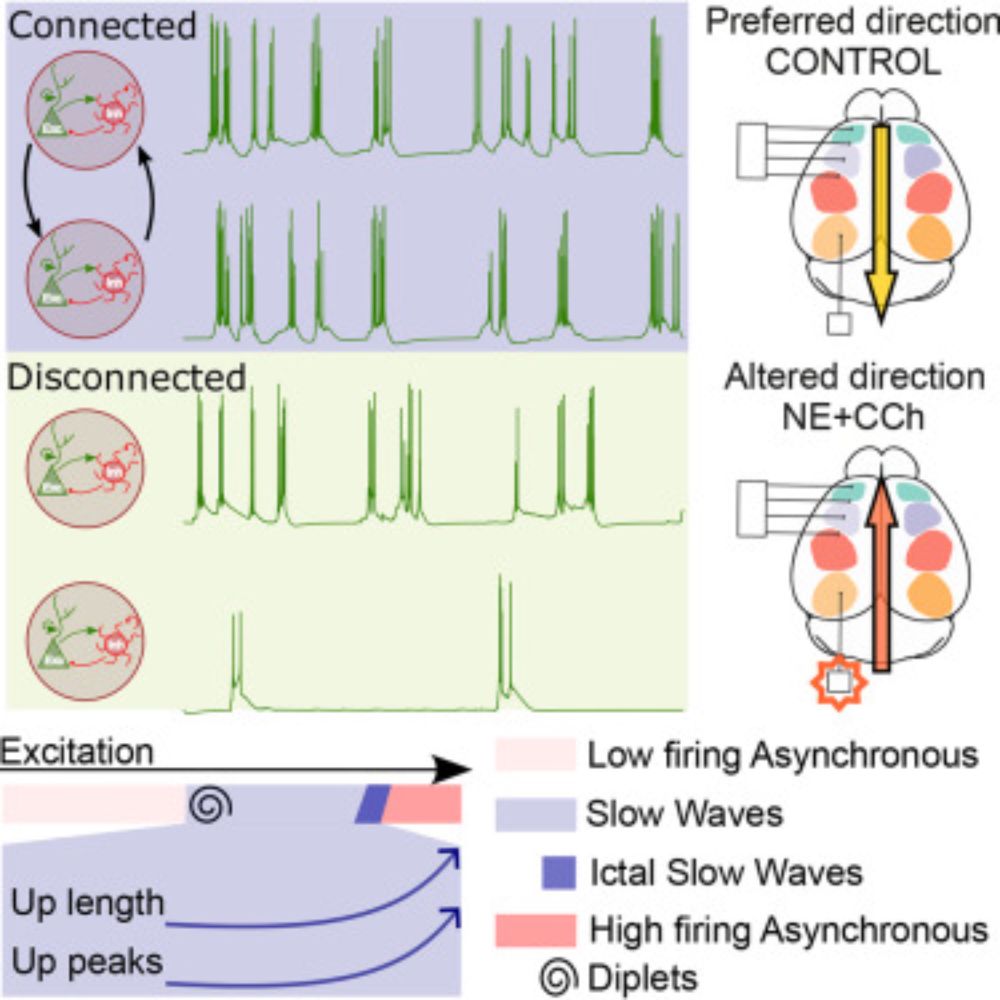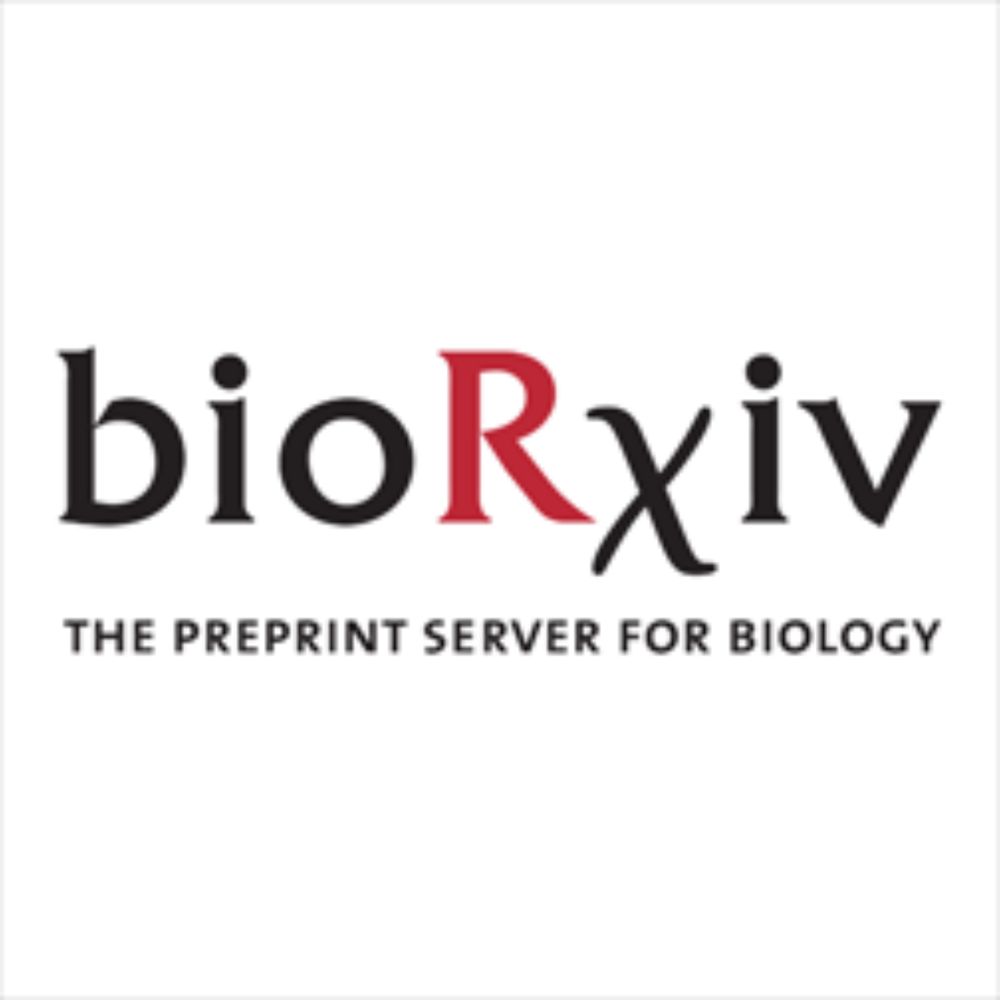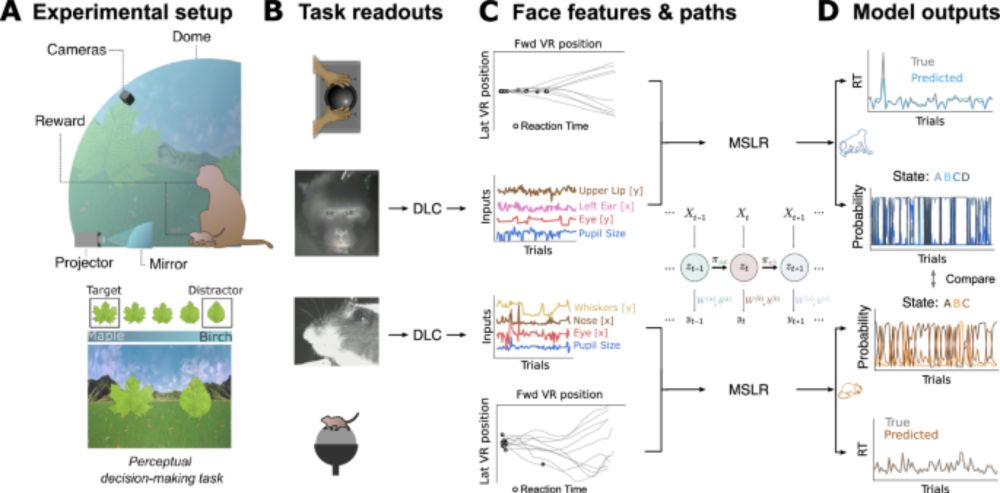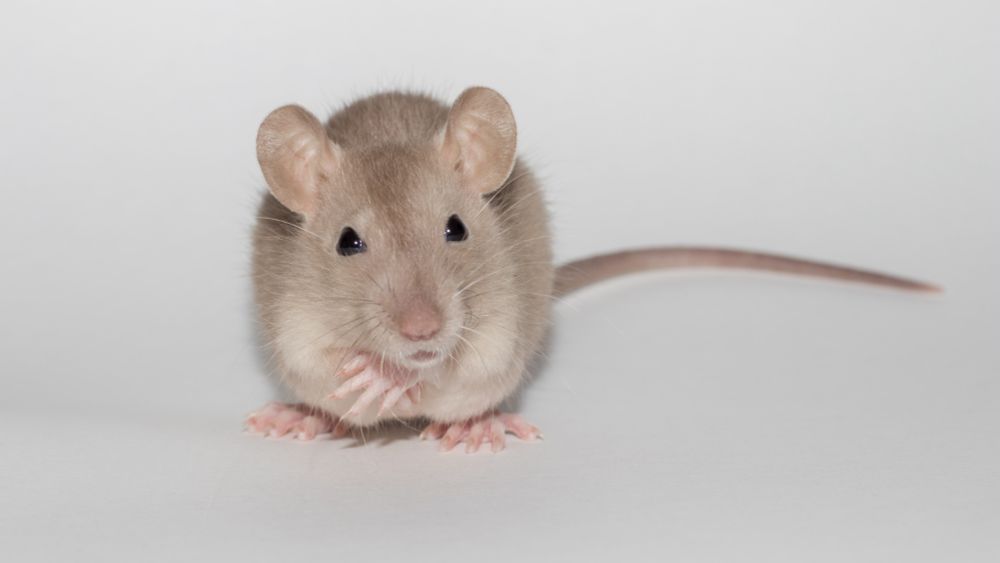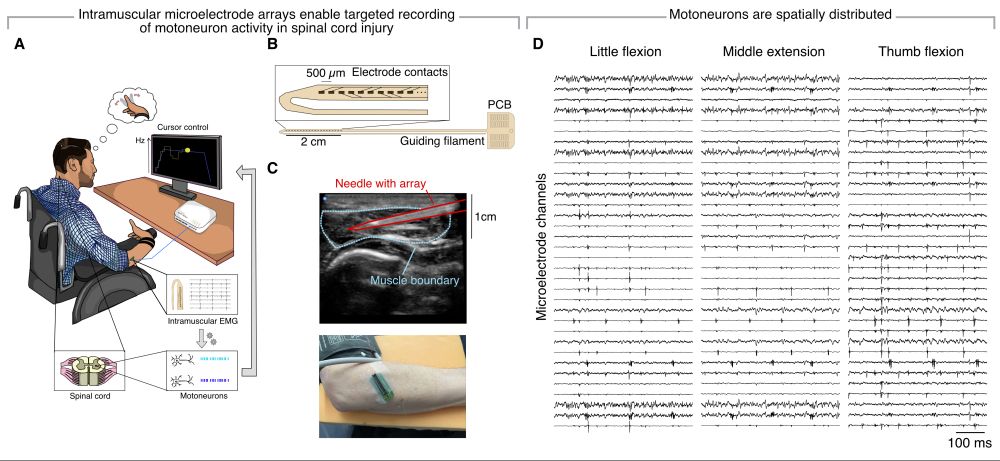

🚨 New preprint + thread 🧵
We've gone back to studying motoneuron control principles and their applications & here's paper #1:
A proof-of-concept study showing that people with tetraplegic spinal cord injury can control up to 2DoF from a single intramuscular implant
www.medrxiv.org/content/10.1...
07.08.2025 11:35 — 👍 40 🔁 6 💬 3 📌 1
Never thought I’d see the day when LinkedIn is the biggest driver of engagement in our papers, but we live in some strange times.
01.08.2025 12:26 — 👍 29 🔁 1 💬 8 📌 0
6/6 This is all thanks to the incredibly talented and passionate Anton Dogadov, who carried this whole study!
Thanks for feedback on our first version of the paper from @gbouvier.bsky.social vier.bsky.social at @neuropsi.bsky.social, Jean-François Léger @ibensens.bsky.social and many others!
01.08.2025 06:25 — 👍 2 🔁 0 💬 0 📌 0

5/6 During cortical wave generation, the response to the movement was reshaped, and lost its relation to limb amplitude, likely being processed to match the task instead.
01.08.2025 06:25 — 👍 0 🔁 0 💬 1 📌 0
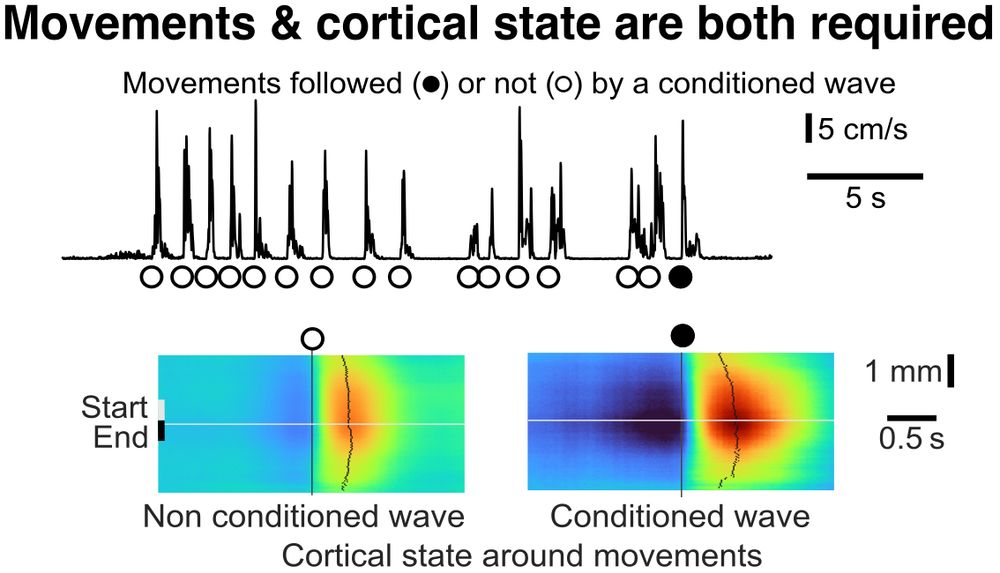
4/6 Importantly, limb movements were likely required to trigger rewardable waves, but were only successful when the cortex was in the specific, suppressed state.
01.08.2025 06:25 — 👍 0 🔁 0 💬 1 📌 0
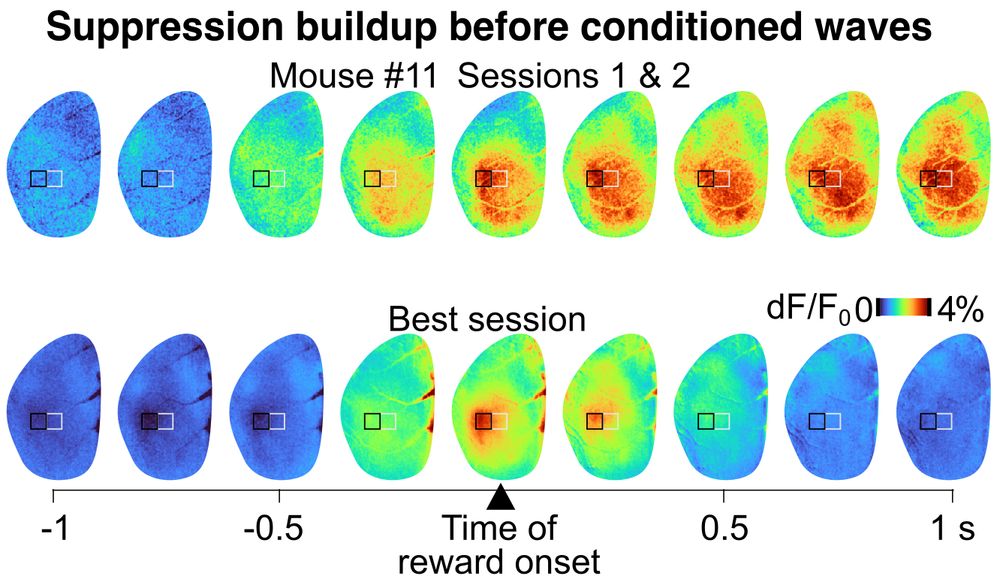
3/6 We have now gone much further, and show that learning this task triggers a reshaping of the cortical dynamics, including a strong suppression of activity before rewardable wave.
01.08.2025 06:25 — 👍 0 🔁 0 💬 1 📌 0
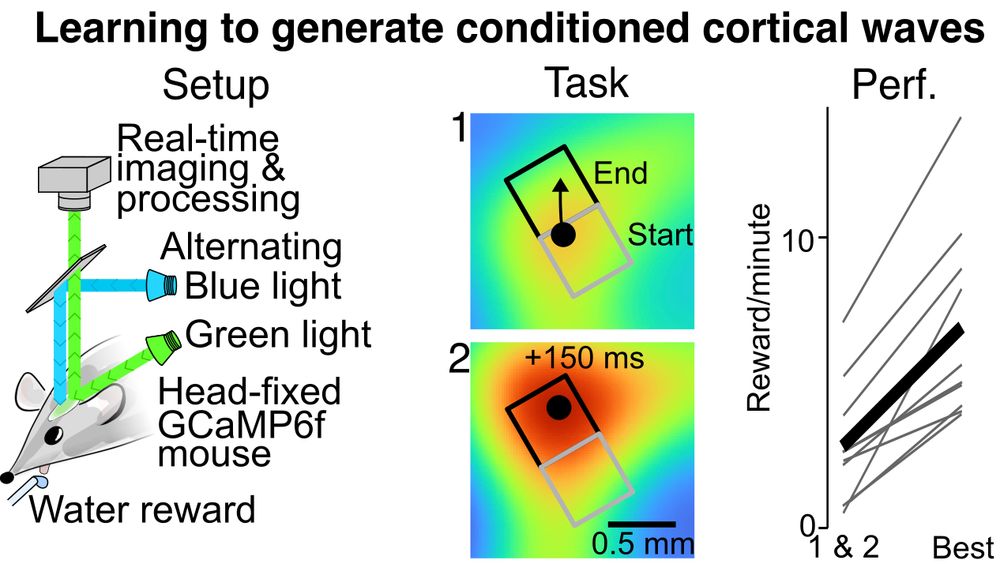
2/6 One year ago, we showed that mice can learn to guide mesoscale cortical of the somatosensory cortex from a start to a target area to obtain rewards.
01.08.2025 06:25 — 👍 0 🔁 0 💬 1 📌 0
1/6 We have a new/updated preprint out, led by Anton Dogadov, demonstrating operant conditioning of large cortical waves over mouse S1 thanks to a mesoscale GCamp6 brain-machine interface!
www.biorxiv.org/content/10.1...
01.08.2025 06:25 — 👍 5 🔁 0 💬 1 📌 1
Redirecting
(1/8)
Excited to share our new paper in @cp-cellreports.bsky.social , led by grad student @rohitrangwani.bsky.social ! 🧠🤖
We show that robust #BrainMachineInterface (#BMI) control is possible using #cerebellar activity- even in a #stroke-affected brain.
#Neuroscience
www.cell.com/cell-reports...
21.07.2025 18:58 — 👍 3 🔁 1 💬 1 📌 2
Octopuses fall for the “rubber arm” illusion, just like us.
Learn more: scim.ag/40xyT4y
22.07.2025 19:56 — 👍 57 🔁 20 💬 0 📌 2
ScienceDirect.com | Science, health and medical journals, full text articles and books.
Two voltage imaging studies in two days using ASAP fluorescent indicators.
First, visualizing electrical brain waves with ASAP3, in Cell. Free link below. Though recorded by EEG for 100 years, how brain waves arise from different neuron types has been unclear.
authors.elsevier.com/sd/article/S...
17.07.2025 19:39 — 👍 24 🔁 6 💬 1 📌 0
Searching for Principles in Motor Control - Sciencesconf.org
Don't miss this upcoming informal gathering on the theme of SEARCHING FOR PRINCIPLES IN MOTOR CONTROL on Sept 23-24, 25 in Sorbonne University. It will enable you to present your work to the French motor community. Registration is free! motorconference.sciencesconf.org
16.07.2025 14:15 — 👍 6 🔁 5 💬 0 📌 0
LinkedIn
This link will take you to a page that’s not on LinkedIn
If you have missed it, wonderful workshop in Montpellier on most recent optical imaging techniques for neurosciences. One week left to register lnkd.in/etEmGyMm
Visit workshop 284
Free registration, accomodation possible on site.
13.07.2025 09:05 — 👍 1 🔁 2 💬 0 📌 0
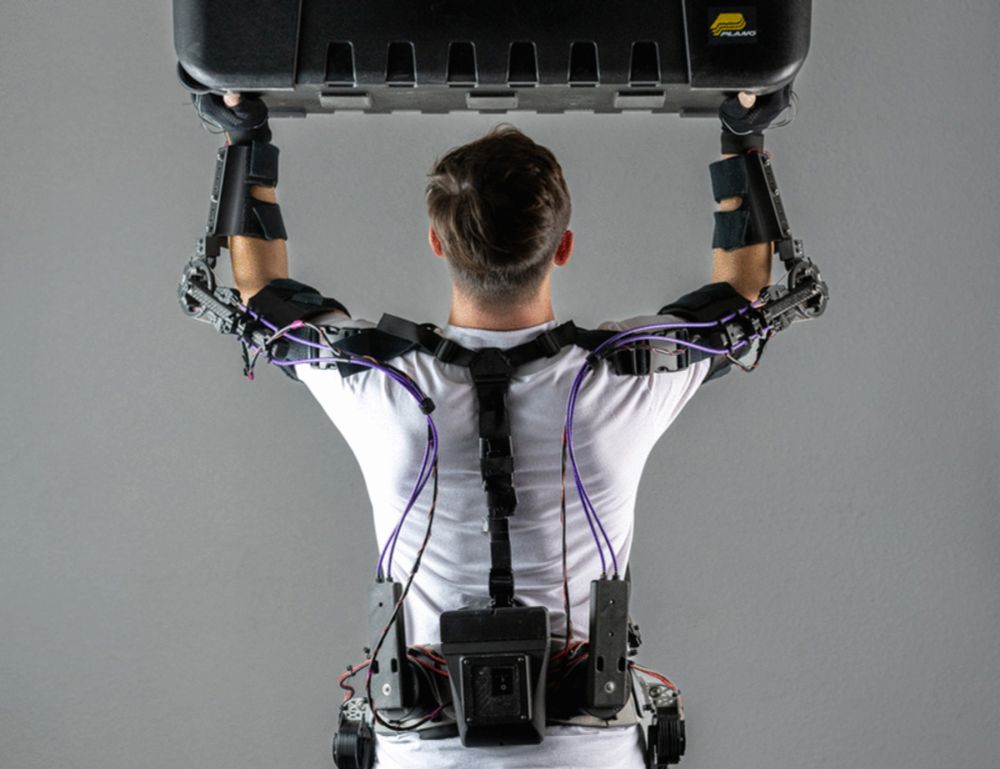
OpenExo: An open-source modular exoskeleton to augment human function
We present an open-source, open-hardware exoskeleton to aid in accelerating the growth of robotic exoskeleton research.
Scientists have developed OpenExo, an open source exoskeleton framework that could make wearable robotics more accessible and accelerate the development of new devices.
Read more in #ScienceRobotics: scim.ag/4koYIKY
07.07.2025 19:15 — 👍 70 🔁 20 💬 3 📌 1
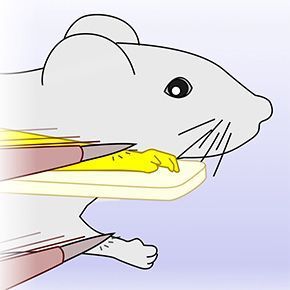
Les souris ont aussi une représentation cognitive riche de leur corps
L’illusion de la « main en caoutchouc » montre que la manipulation astucieuse de perceptions visuelles et tactiles peut nous convaincre en quel
Les souris ont-elles aussi une représentation cognitive de leur corps ?
🤝 @cnrs-paris-saclay.bsky.social @univparissaclay.bsky.social @lucestebanez.bsky.social @touchmovelab.bsky.social @neuropsi.bsky.social
👉 Lire l'article dans @plosbiology.org
buff.ly/2JK2msI
05.07.2025 05:00 — 👍 7 🔁 5 💬 0 📌 0
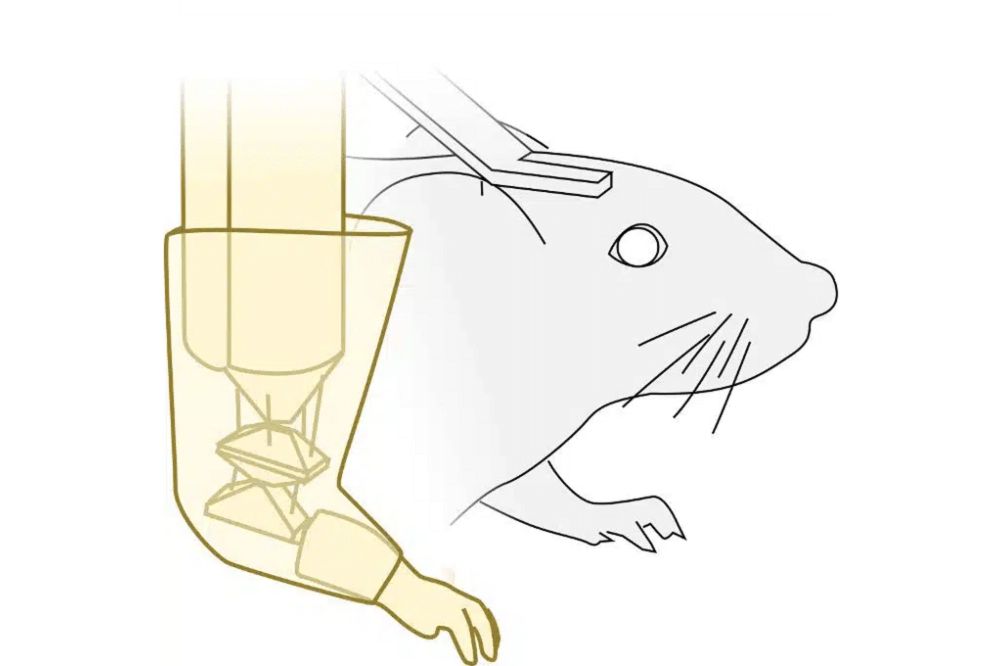
Le projet Neurocontrol : où les neurosciences rencontrent l’automatique – MITI
Retrouver l'interview des porteurs du projet Neurocontrol, fruit d’une collaboration entre neuroscientifiques et automaticiens
🎉 L'interdisciplinarité est à l'oeuvre dans notre institut.
🤝 Nos liens forts avec la communauté des ingénieurs du L2S @centralesupelec.bsky.social nous valent le label PRIME de @cnrs.fr !
02.07.2025 10:41 — 👍 2 🔁 3 💬 0 📌 0
🔬🐁 We have a new position open!
➡️ Our "Chaire Professeur Junior" position focuses on multi-omics during brain development. This research-heavy position follows a tenure-track scheme, leading to a full professor position.
🗓️ Application deadline: 22/08/2025
28.06.2025 15:18 — 👍 6 🔁 7 💬 0 📌 0
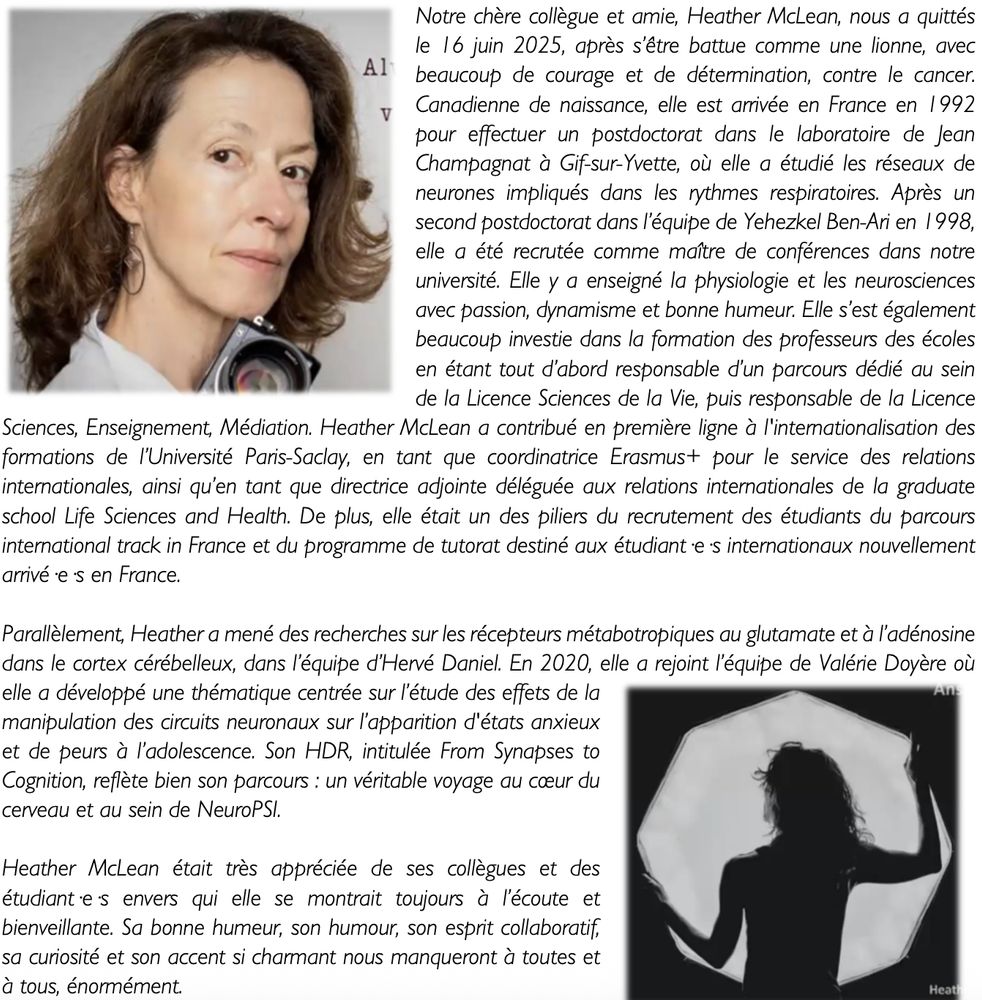
Notre chère collègue et amie, Heather McLean, nous a quittés le 16 juin 2025, après s’être battue comme une lionne, avec beaucoup de courage et de détermination, contre le cancer. Canadienne de naissance, elle est arrivée en France en 1992 pour effectuer un postdoctorat dans le laboratoire de Jean Champagnat à Gif-sur-Yvette, où elle a étudié les réseaux de neurones impliqués dans les rythmes respiratoires. Après un second postdoctorat dans l’équipe de Yehezkel Ben-Ari en 1998, elle a été recrutée comme maître de conférences dans notre université. Elle y a enseigné la physiologie et les neurosciences avec passion, dynamisme et bonne humeur. Elle s’est également beaucoup investie dans la formation des professeurs des écoles en étant tout d’abord responsable d’un parcours dédié au sein de la Licence Sciences de la Vie, puis responsable de la Licence Sciences, Enseignement, Médiation. Heather McLean a contribué en première ligne à l'internationalisation des formations de l’Université Paris-Saclay, en tant que coordinatrice Erasmus+ pour le service des relations internationales, ainsi qu’en tant que directrice adjointe déléguée aux relations internationales de la graduate school Life Sciences and Health.
Parallèlement, Heather a mené des recherches sur les récepteurs métabotropiques au glutamate et à l’adénosine dans le cortex cérébelleux, dans l’équipe d’Hervé Daniel. En 2020, elle a rejoint l’équipe de Valérie Doyère où elle a développé une thématique centrée sur l’étude des effets de la manipulation des circuits neuronaux sur l’apparition d'états anxieux et de peurs à l’adolescence. Son HDR, intitulée From Synapses to Cognition, reflète bien son parcours : un véritable voyage au cœur du cerveau et au sein de NeuroPSI.
Heather McLean était très appréciée de ses collègues et des étudiant·e·s envers qui elle se montrait toujours à l’écoute et bienveillante. Sa bonne humeur, son esprit collaboratif et sa curiosité nous manqueront à toutes et à tous, énormément.
C'est notre grande tristesse d'annoncer le décès de Heather McLean, Maitresse de Conférence en neuroscience à @univparissaclay.bsky.social, chercheuse à @neuropsi.bsky.social.
25.06.2025 19:50 — 👍 4 🔁 3 💬 1 📌 1
I am extremely grateful and beyond happy to share that I have been awarded an @inserm.fr #ATIP-Avenir fellowship to start my own lab to study neuronal circuits for auditory categorization! Thanks to everyone who made this possible.
26.06.2025 13:20 — 👍 26 🔁 2 💬 6 📌 1
Two postdoc positions in the lab within the ERC Synergy project "Chronology" in collaboration with S. Ostojic, M. Jazayeri and V. van Wassenhove @virginievanw.bsky.social . Two focuses: sound sequences representations across the brain & novel all-optical technology. Contact: brice.bathellier@cnrs.fr
15.06.2025 08:20 — 👍 15 🔁 13 💬 0 📌 1
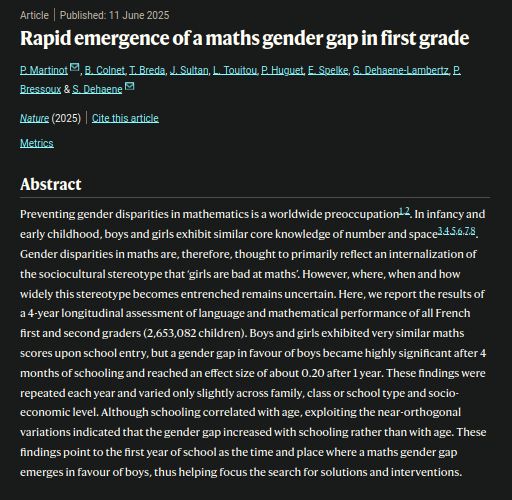
Preventing gender disparities in mathematics is a worldwide preoccupation1,2. In infancy and early childhood, boys and girls exhibit similar core knowledge of number and space3,4,5,6,7,8. Gender disparities in maths are, therefore, thought to primarily reflect an internalization of the sociocultural stereotype that ‘girls are bad at maths’. However, where, when and how widely this stereotype becomes entrenched remains uncertain. Here, we report the results of a 4-year longitudinal assessment of language and mathematical performance of all French first and second graders (2,653,082 children). Boys and girls exhibited very similar maths scores upon school entry, but a gender gap in favour of boys became highly significant after 4 months of schooling and reached an effect size of about 0.20 after 1 year. These findings were repeated each year and varied only slightly across family, class or school type and socio-economic level. Although schooling correlated with age, exploiting the near-orthogonal variations indicated that the gender gap increased with schooling rather than with age. These findings point to the first year of school as the time and place where a maths gender gap emerges in favour of boys, thus helping focus the search for solutions and interventions.

Ecart de genre en maths à T1 (début CP), T2 (janvier CP) et T3 (début CE1) en fonction de l'âge des enfants en mois lors de la passation du test, pour les quatre années de cohorte (d de Cohen). Étant donné que l'entrée à l'école est strictement déterminée par la date de naissance, les enfants du même âge peuvent différer dans leur durée de scolarisation (couleurs et lignes de régression). Quel que soit l'âge auquel ils ont passé le test, les enfants présentaient un écart minime ou nul entre les sexes en mathématiques à T1, mais l'effet s'est accentué après 4 mois (T2) et 12 mois (T3) de scolarisation.
Du poids indéniable de l'école dans la production des inégalités genrées face aux mathématiques
"Rapid emergence of a maths gender gap in first grade"
par P. Martinot et al.
Une étude sur 3 million d'enfants en France (!!!) qui va faire du bruit
#LaRAC @nature.com
www.nature.com/articles/s41...
12.06.2025 14:32 — 👍 88 🔁 52 💬 4 📌 4
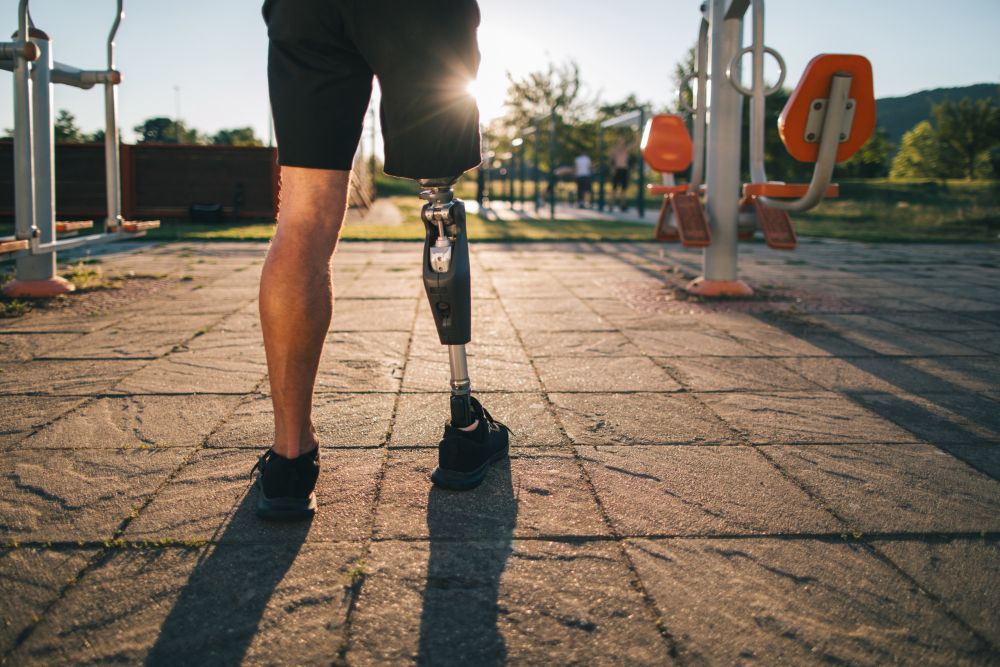
Scientists trick mice with human experiment with 'unparalleled' value
"This opens up many opportunities."
🐀💪More coverage of our latest mouse limb embodiment work @plosbiology.org in @newsweek.com !
11.06.2025 16:44 — 👍 7 🔁 2 💬 0 📌 0
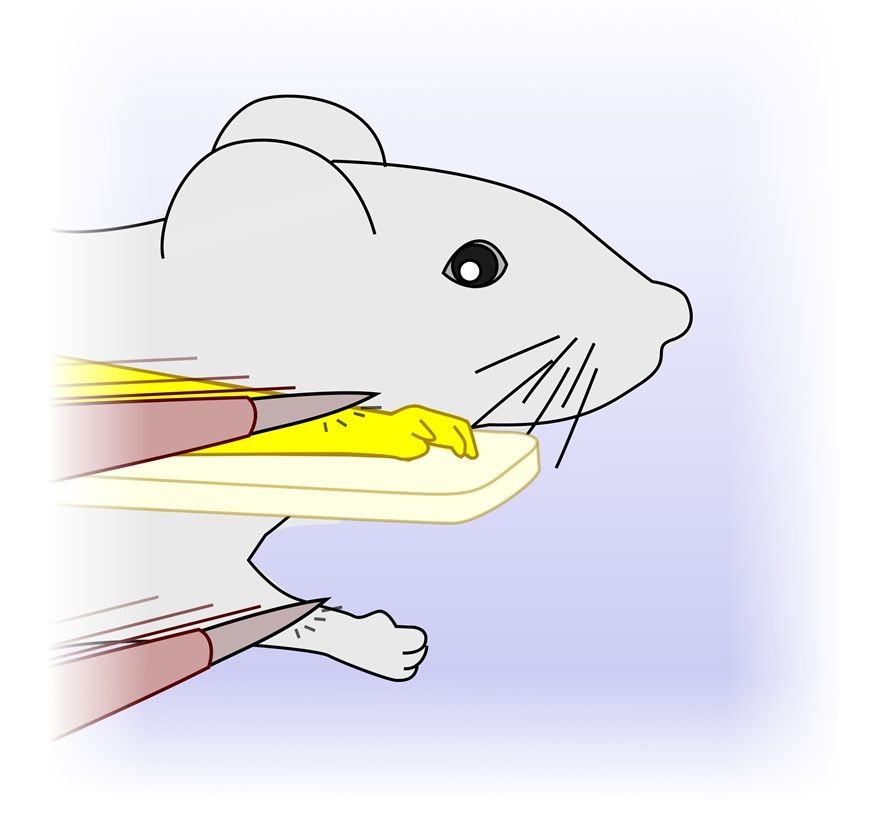
The rubber-hand illusion was translated to the mouse model. Just like in humans, embodiment in mice can be achieved by brushing the real forelimb of the mouse and the artificial limb (yellow) in synchrony to generate matching visual and touch percepts. This study suggests that as the mouse looks at the artificial limb, it perceives it as its own limb, and feels threatened if the artificial limb is threatened. Image credit: Luc Estebanez.
The "rubber hand illusion" in mice... @lucestebanez.bsky.social &co use automated videography to show that mice display quantifiable behavioral markers of the embodiment of an #ArtificialLimb, opening the door to future research into human #BodyOwnership disorders @plosbiology.org 🧪 plos.io/4jHsESn
10.06.2025 08:08 — 👍 6 🔁 2 💬 0 📌 0
thank you Rémi!
06.06.2025 08:47 — 👍 0 🔁 0 💬 0 📌 0
🎉 Congratulations to Zineb Hayatou and all members of our team @touchmovelab.bsky.social at @neuropsi.bsky.social @cnrsbiologie.bsky.social @univparissaclay.bsky.social!
👍 Many thanks to collaborators Hongkai Wang (Dalian U. Technology, China) and Antoine Chaillet @centralesupelec.bsky.social.
05.06.2025 21:06 — 👍 3 🔁 0 💬 0 📌 0
We tweeted the details of this story a while ago when the BioRxiv came out:
05.06.2025 21:06 — 👍 3 🔁 0 💬 1 📌 0
Executive Vice-President for a Clean, Just and Competitive Transition and Commissioner for Competition.
European Commission (2024-2029)
23, ukrainian-american
Print FPV drones like money and we’re hyperinflating
Défense🛡️, Sciences🔬 et Requins🦈
PI neurobiologist at CNRS France. Thalamocortical oscillations, sleep, interneurons.
I explore how brain-machine interfaces can help restore sensorimotor functions and what they teach us about brain plasticity.
Postdoc at @karalis-lab.bsky.social - @institutducerveau.bsky.social
I create computational models to build hypothesis and make predictions.
Philosophy of science aficionado
Ministre de l’Europe et des Affaires étrangères • Conseiller régional d'Ile-de-France • Vice-Président du Modem
Troll patenté de la twittosphère défense
EU High Representative for Foreign Affairs and Security Policy
Vice-President of the European Commission
Du Starship à l’astromodélisme, de ULA à BPS, d’Ariane à Latitude. Avec des flammes ou non, si c’est pointu et que ça vole à la vertical, faut qu’on en cause !
🇫🇷 scientist in 🇩🇪 after 🇦🇺, 🇬🇧, 🇦🇺, 🇨🇦, 🇬🇧...
Part-time Prof. also in 🇬🇧
🔬(⚛️,🧊) for materials used for ⚡️🔋✈️🛠️🪨🧲♻️🦠🧪
Dad to 🌸, husband to ☮️
Has a 🐕
https://sites.google.com/view/batomprobe/home
Bienvenu.e sur le compte officieux de la Présidence de la République française et du palais de l'Élysée
Assemblymember. Democratic Nominee for Mayor of NYC. Running to freeze the rent, make buses fast + free, and deliver universal childcare. Democratic Socialist. zohranfornyc.com
Christian, husband, dad. Vice President of the United States.
jdvance.com
Official account of the French Joint Staff. Latest news on 🇫🇷 military operations.
➡️ @cemafr.bsky.social for the Chief of the French Defence Staff
➡️ @etatmajorfr.bsky.social for the French latest news
▪️ GĖOPOLITIQUE >> 🌍 (focus 🇺🇦 🇷🇺 🇪🇺 🇺🇸 🇵🇸 🇮🇱 🇦🇷 🇹🇬)
▪️ ACTUS >> Vie publique 🏛️ 🇫🇷 | Numérique 💻 | Nature 🌳 | #Nantes 📍
▪️ DÉTENTE >> 🪶 📷 🎸 🚲
Striving to understand the relationship between brain and behavior.
www.plutalab.com
Would rather be in Iceland. 📷🏔️
Assistant Professor at Cedars-Sinai/ UCLA.
Neuroscientist 🧠 / Neural Engineer interested in cortico-cerebellar mechanisms of motor learning, sleep and memory, neurorehabilitation. Posts are my own.
gulatilab.org
Author of THE NOTWITCHES, out now! All the links for ordering can be found at garypanton.co.uk/books/
Represented by Rachel Mann at CAA.
📍Perth, Scotland
🌐 garypanton.co.uk







